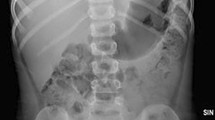Abstract
Foreign body ingestion in small children is common yet only 1% of cases require operative management of associated complications (Arana et al. in Eur J Pediatr 160:468–472, 2001). A 6-year-old boy was referred to our institution with a 12 h history of abdominal pain. This pain was diffuse and crampy in nature and associated with multiple episodes of non-bilious, non-bloody emesis. On evaluation he was stable and his abdomen demonstrated slight distention and tenderness without peritoneal signs. Plain abdominal radiographs demonstrated some distended loops of small bowel and a radio-opaque foreign object within the mid-abdomen. A small bowel obstruction secondary to foreign body ingestion was diagnosed and an emergent laparotomy performed. Upon exploration, a transition zone was noted near the ileocecal valve. Further exploration revealed the obstruction to be caused secondary to the apposition of two small (8 mm) magnets, one in the proximal ileum and the other near the ileocecal valve, resulting in an internal hernia. The magnets were easily separated relieving the obstruction and both were removed via two small bowel enterotomies. After being presented with the magnets, his parents suspected that they came from the clothes of a Polly Pocket® (Mattel, Inc., El Segundo, CA) doll. The patient had an uneventful post-operative course and was discharged to home on the second post-operative day. This case demonstrates the complications that may occur with multiple magnet ingestion. It highlights the need for close observation and early surgical intervention in children with a suspected history of foreign body ingestion, a clinical picture of gastrointestinal distress, and radiographic evidence of a radio-opaque foreign object.



Similar content being viewed by others
References
Hebra A, Tagge EP (2003) Esophagoscopy and esophageal foreign bodies. In: Ziegler MM, Azizkhan RG, Weber TR (eds) Operative pediatric surgery. McGraw-Hill, New York, pp 331–339
Arana A, Hauser B, Hachimi-Idrissi S et al (2001) Management of ingested foreign bodies in childhood and review of the literature. Eur J Pediatr 160:468–472
Blaho KE, Merigian KS, Winbery SL et al (1998) Foreign body ingestions in the Emergency Department: case reports and review of treatment. J Emerg Med 16:21–26
US Consumer Product Safety Commission (2006) Child’s death prompts replacement program of magnetic building sets. Office of Information and Public Affairs, Washington, DC, Release #06–127, 31 March 2006. http://www.cpsc.gov/cpscpub/prerel/prhtml06/06127.html
Nardi E (2005) Stores recall toy after boy swallows some pieces, dies. In: The Salt Lake Tribune. Salt Lake City, UT, 29 December
Tay ET, Weinberg G, Levin TL (2004) Ingested magnets: the force within. Pediatr Emerg Care 20:466–467
Cauchi JA, Shawis RN (2002) Multiple magnet ingestion and gastrointestinal morbidity. Arch Dis Child 87:539–540
Chung JH, Kim JS, Song YT (2003) Small bowel complication caused by magnetic foreign body ingestion of children: two case reports. J Pediatr Surg 38:1548–1550
Kubota Y, Tokiwa K, Tanaka S et al (1995) Intestinal obstruction in an infant due to magnet ingestion. Eur J Pediatr Surg 5:119–120
Lee SK, Beck NS, Kim HH (1996) Mischievous magnets: unexpected health hazard in children. J Pediatr Surg 31:1694–1695
Nui A, Hirama T, Katsuramaki T et al (2005) An intestinal volvulus caused by multiple magnet ingestion: an unexpected risk in children. J Pediatr Surg 40:e9–e11
Uchida K, Otake K, Iwata T et al (2005) Ingestion of multiple magnets: hazardous foreign bodies for children. Pediatr Radiol 36:1–2
Wildhaber BE, Le Coultre C, Genin B (2005) Ingestion of magnets: innocent in solitude, harmful in groups. J Pediatr Surg 40:e33–e35
Honzumi M, Shigemori C, Ito H et al (1995) An intestinal fistula in a 3-year-old child caused by the ingestion of magnets: report of a case. Surg Today 25:552–553
Litovitz T, Schmitz BF (1992) Ingestion of cylindrical and button batteries: an analysis of 2382 cases. Pediatrics 89:747–757
Litovitz TL (1985) Battery ingestions: product accessibility and clinical course. Pediatrics 75:469–476
Author information
Authors and Affiliations
Corresponding author
Rights and permissions
About this article
Cite this article
Fenton, S.J., Torgenson, M., Holsti, M. et al. Magnetic attraction leading to a small bowel obstruction in a child. Pediatr Surg Int 23, 1245–1247 (2007). https://doi.org/10.1007/s00383-007-1997-4
Accepted:
Published:
Issue Date:
DOI: https://doi.org/10.1007/s00383-007-1997-4




